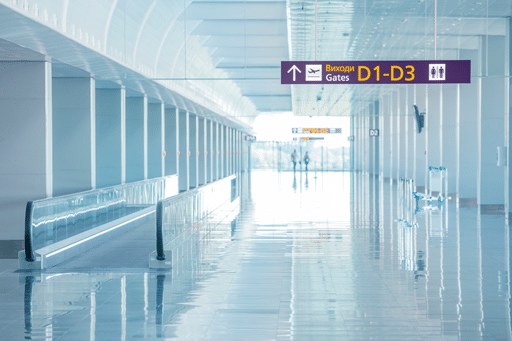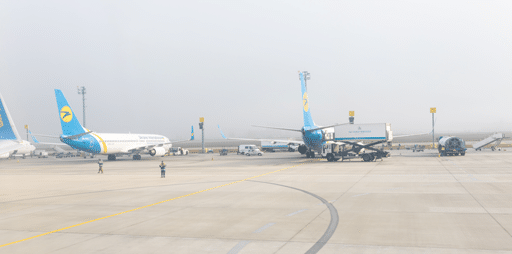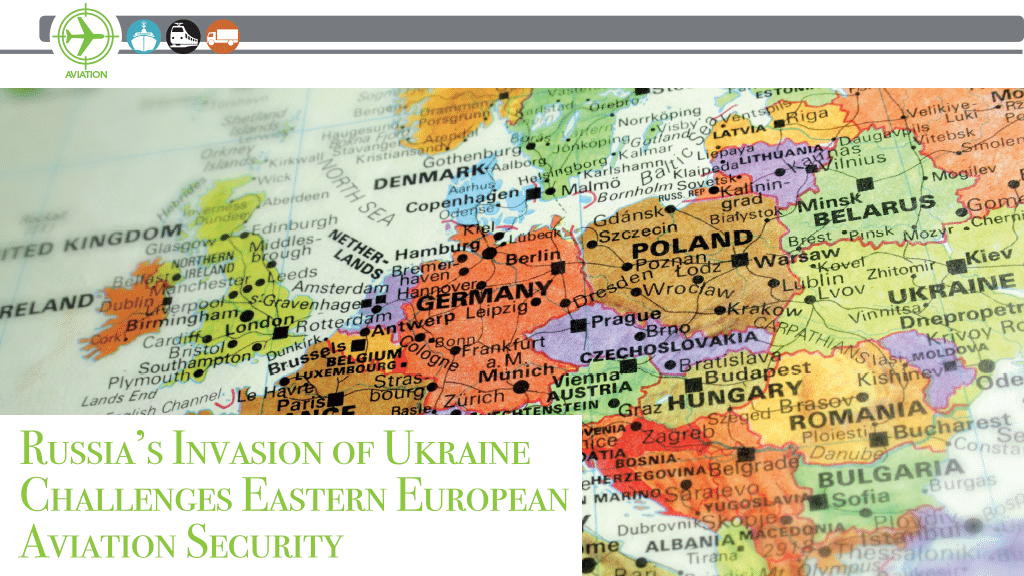Since it began in February 2022, Russia’s ongoing invasion of Ukraine has upended aviation security in Eastern Europe. Everything from flight planning to baggage screening and passenger check-ins have been affected by this serious disruption of European airspace.
Impact on Flight Operations
Eastern European flight planning has been greatly affected by the conflict. In response to Russia’s unprovoked aggression against Ukraine, the United States, the European Union, and Canada closed their airspace to Russian aircraft. The Putin regime responded to these restrictions with a tit-for-tat ban on aircraft from these countries over its territory.
Not surprisingly, “Airspace closures and flight bans have severely impacted civilian flight operations, particularly regarding the use of Russian airspace,” said Matthew Borie, chief intelligence officer with Osprey Flight Solutions, a U.K. firm that specializes in assessing global aviation security risks. “Russia has blocked air carriers registered in western states (i.e., EU, U.S., Canada, etc.) from accessing Russian airspace for overflights in response to those states blocking Russian registered aircraft from accessing their respective airspaces. In addition, many air carriers registered in the Asia-Pacific region have chosen to avoid using Russian airspace based on internal decision-making — even though they are not barred from accessing Russian airspace by Russia. This has led to significant increases in flight times, distances and costs.”

Riga International Airport
Russia’s isolation from global aviation has resulted in a noticeable “reduction of air carrier flight destinations towards the East (Russia, Belorussia, and Ukraine),” added Inta Smildzina, deputy director security department at Riga International Airport. “This correspondingly affects the number of transit passengers. [But] The situation in the context of ensuring aviation security processes and establishing security measures at Riga Airport has practically not changed.”
Although Ukraine has not banned international air traffic, the risk of civilian flights coming under attack during their transit of this contested airspace has increased. This is why the European Union Aviation Safety Agency (EASA) issued a Conflict Zone Information Bulletin (CZIB) regarding the overflight of Ukraine on February 24, 2022, the first day of the Russian invasion of that country. It is available online at https://www.easa.europa.eu/en/domains/air-operations/czibs/czib-2022-01r08. Given its relevance to the state of Eastern European aviation security, this CZIB is worth examining in detail.
“In the light of the latest developments, in particular: on-going military activities in the territory of Ukraine; the NOTAM A0003/23 issued by Ukraine stating that FIR LVIV (UKLV), FIR KYIV (UKBV), FIR DNIPROPETROVSK (UKDV), FIR SIMFEROPOL (UKFV), FIR OESA (UKOV) are closed for civil aviation flights; and the information on a Danger Area affecting, inter alia, the airspace of Ukraine and neighboring countries, issued by the Russian Federation, air operators are reminded that the affected airspace defined above is an active conflict zone or is bordering an active conflict zone,” said the EASA CZIB. “Under these circumstances, the aforementioned airspace and critical infrastructure, including airports, are exposed to military activities which result in safety risks for civil aircraft. In particular, there is a risk of both intentional targeting and misidentification of civil aircraft. The presence and possible use of a wide range of ground and airborne warfare systems poses a HIGH risk for civil flights operating at all altitudes and flight levels.”

Given the serious risks for civilian aircraft over Ukraine, the EASA CZIB recommended that “Operators should not operate within the aforementioned airspace, including landing and departures from airports located in the affected airspace. Additionally, operators should exercise caution when operating in the whole FIR Moscow (UUWV) due to heightened military activity which may include launches of mid-range missiles penetrating into controlled airspace.
Operators are reminded that operations within FIR MINSK (UMMV) are prohibited in accordance with EASA Safety Directives SD-2021-02 and SD-2021-03.”
“The situation remains fluid and subject to rapid change. EASA will monitor the developments and will adjust the recommendations accordingly.”
As detailed as this EASA CZIB appears to be, it does not impress Osprey’s Borie.
“As the Russian invasion of Ukraine has shown, expecting regulators to be proactive and flexible in their approach to conflict zones is unrealistic,” he said. “This means aviation operators who depend solely on regulators for decision-making support on conflict zones are avoiding notable swathes of airspace and its ‘costing’ (fuel, insurance and so forth) in many ways.”
This is where a dedicated aviation security solutions firm such as Osprey Flight Solutions can make a difference for airlines operating in Eastern Europe, by providing a range of options that are aligned with their needs and economic constraints. “Osprey advises operators to move towards a solution that provides dynamic, timely and accurate data-led security risk assessments for long-haul flights near/over conflict zones,” explained Borie. In contrast, airspace regulators present airspace risk “in terms of whole countries or flight information regions (FIRs), meaning that a notable portion of the globe is covered by conflict zone notices, restrictions, prohibitions, advisories, bulletins, circulars and/or publications issued by leading civil aviation governing bodies (U.S. FAA, U.K. DfT, German LBA, French DGAC, Transport Canada and EASA). The governing bodies rarely change their notices, and the areas they cover are not specific to airways, times of day and, in some cases, altitude levels.”
Having said this, Osprey’s Borie pointed out that the EASA did partner with his company to launch the “European Information Sharing and Cooperation Platform on Conflict Zones” (the Platform), shortly after the Russian invasion of Ukraine. This platform is designed to allow members of the European aviation community “to share information on threats to civil aviation arising from zones of conflict or armed insurgency,” the website said. “The purpose of the Platform is to support the existing EU Conflict Zone Alerting System and particularly the ‘Integrated EU Aviation Security Risk Assessment Group’ to improve the availability and swiftness of relevant information exchange. The Platform has been designed to assist institutions and air operators to conduct their risk assessments in a timely manner and quickly implement appropriate mitigation measures to ensure safety and security of flight.”
What makes this Platform useful for European aircraft operators is the fact that it displays all relevant data about threats to aircraft in Europe on a single web-based map. It also allows users to post information about these threats on the Platform to maximize intelligence sharing. The data being displayed by the EASA is sourced from Osprey’s aviation security database, which the company says is the largest of its kind in the industry. Membership to the Platform is limited to European Union institutions/agencies acting in the area of aviation safety and security or home affairs; EASA member state civil aviation authorities and relevant governmental institutions; and commercial aviation operators recognized by the EASA or its member states.
According to Borie, this Platform “has assisted EU governments, EU registered air carriers and EU airports to better understand the risks stemming from conflict zones,” he said, including those in Eastern Europe. “However, beyond this, very little government support has been put in place and the onus is clearly on air carriers to take definitive steps to improve their risk management programs across their network of flights.”
Limited Impact on Airport Operations
There is no doubt that the Russian invasion of Ukraine has heightened security concerns at Eastern European airports. However, given that we live in the post 9/11 era, security was already being taken seriously at these venues. Such a “security culture” approach to airport/aviation safety has been promoted for years by the International Civil Aviation Organization (ICAO). On its “Security Culture” website, ICAO states that, “Security should be everyone’s responsibility — from the ground up and top down. Effective security culture is about recognizing that effective security is critical to business success; establishing an appreciation of positive security practices among employees; aligning security with core business goals; and articulating security as a core value rather than as an obligation or a burdensome expense.”
As a result, the Ukrainian invasion certainly motivated Eastern European airport facilities to ensure the strength of their passenger screening, baggage checks and on-site security measures. But it did not inspire them to do so, because fears about hostile players were well-founded and responded to before the first Russian tank rolled across Ukraine’s border. As a result, the Russian invasion has had limited impact on Eastern European airport operations as a whole, besides cutting deeply into passenger traffic and its attendant economic effects.
“Aviation security procedures were in place at Eastern European airports long before Russia’s 2022 invasion of Ukraine, and are still being developed based on international and national regulatory requirements,” said Riga International Airport’s Inta Smildzina. “This is true at my airport, where aviation security procedures and programs have been developed and are being implemented in accordance with Regulation No. 300/2008 of the European Parliament and of the Council of 11 March 2008 on common rules in the field of civil aviation security.” She added that the overall threat level for Latvia as a whole is determined and updated by the state institutions responsible for security. “Appropriate procedures have been developed in the country for coordinated action and cooperation among state institutions and aviation companies in the event of different levels of threat, and they are periodically reviewed/updated.”

On a continental basis, “EU member states have maintained a high level of aviation security through implementing the EU aviation security legislation before the invasion of Ukraine, and also since then,” said European Commission spokesperson Deborah Almerge-Ruckert. “There has been no change to specific aviation security measures at EU airports in Eastern Europe (or elsewhere in the EU) stemming from the invasion.”
Almerge-Ruckert’s “stay the course’”assessment is echoed by Smildzina. “Latvia’s civil aviation authority and the European Commission — each at their own level and according to their competence — carry out permanent monitoring measures in the field of aviation security, setting additional procedures if necessary,” she said. “The existing procedures both at the national level and at Riga Airport were reviewed and accepted as relevant to the current situation and threat level.”
Global Implications
This being said, the increased shipment of weapons into Ukraine — with their vulnerability to being stolen and resold by unscrupulous criminals — is a growing concern to the Eastern European aviation sector, and the world in general.
In fact, “Osprey continues to track the proliferation of small arms and light weapons within the Russia-Ukraine conflict that could pose a future threat to aviation security globally,” said Borie. “In late October 2022, the U.S. State Department issued the ‘U.S. Plan to Counter Illicit Diversion of Certain Advanced Conventional Weapons in Eastern Europe’, which highlights a specific focus on properly securing man-portable air defense systems (MANPADS) capable of targeting aircraft below FL260 present in the Russia-Ukraine conflict. The State Department notes in the plan that ‘pro-Russian forces’ capture of Ukrainian weapons — including donated materiel — has been the main vector of diversion so far. This could result in onward transfers and the possibility that ‘Russia probably will also use these weapons to develop countermeasures, propaganda, or to conduct false-flag operations’.”
To counter the threat of weapons thefts and re-use by hostile players, the U.S. plans to work with its allies and Ukraine in a multi-year, multi-faceted effort. Tactics include “Bolstering the ability of security forces in Ukraine and its neighboring states to account for and safeguard their arms and ammunition during transfer, in storage, and when deployed; strengthening border management and security in Ukraine and its neighboring states; and building the capacity of security forces, law enforcement officials, and border control agencies in Ukraine and its neighboring states to deter, detect, and interdict illicit trafficking of certain advanced conventional weapons,” said the U.S. State Department statement.

Based on its own security assessments, Osprey believes that Russian, pro-Russian forces and Ukrainian stockpiles of MANPADS are at risk of proliferation beyond the control of the states within the conflict, as well as potentially abroad. “While there is currently no indication that external violent non-state actor (VNSA) groups have gained access to MANPADS as a result of the conflict, such equipment may be captured by Russian forces, exploited by paramilitary/militia groups and more extreme elements currently operating in the conflict, or sold on to external buyers,” Borie observed. “The latter poses the risk of external VNSAs being able to acquire highly capable MANPADS and this is a key concern from a global aviation security perspective.”
Lessons to be Learned
The fallout experienced by Eastern European aviation in the wake of the 2022 Ukrainian invasion has been painfully instructive for operators and regulators in this region, and those observing the situation from afar in other countries around the globe.
These lessons are worth taking to heart, because the chaos inflicted here by Russia’s military adventurism could well occur in other regions of the world.

Osprey Flight Solutions
“The key takeaway from the Russian invasion of Ukraine, in my view, is that there is now a clear picture of what the fallout from a global geopolitical crisis involving state versus state armed conflict will have on the aviation industry,” said Borie. “The impact on European aviation from the Russian invasion of Ukraine has been significant. Were a China-Taiwan conflict to occur, the fallout would be immense and likely far exceed the negative effects on the industry that the Russian invasion of Ukraine has. This isn’t so much a ‘surprise’ related to that crisis but rather a ‘red flag’ for the future, should a similar yet more expansive and complex global geopolitical crisis involving state versus state armed conflict emerge regarding China-Taiwan in the wake of the Russian invasion of Ukraine.”
“It is difficult to predict future challenges,” said EC spokesperson Almerge-Ruckert. “The EU, through its legislative framework and mechanisms of cooperation between the European Commission and EU member states, is well prepared to address future challenges coming from the evolving threats against civil aviation.”
As for the post-invasion security concerns of Eastern European aviation going forward?
“For both Eastern Europe and aviation in general, the challenges are future technologies, innovations and their implementation processes,” Smildzina replied. “For example, the main future challenges in the field of aviation security for Riga Airport are related to the planned creation of a new security checkpoint within the airport terminal expansion project and, accordingly, the introduction of new, innovative aviation security technologies, their integration into modern infrastructure with the aim of providing passengers and clients with high-quality services and the best experience. The airport has already started work on the procurement of new equipment.”
The bottom line: Russia’s invasion of Ukraine and its global consequences has certainly made life more challenging for the Eastern European aviation industry, but has not fundamentally changed its day-to-day realities. Yes, cross-border flights are no longer through Russian and Ukrainian airspace, but commercial aviation remains alive and functional in this region nonetheless.
